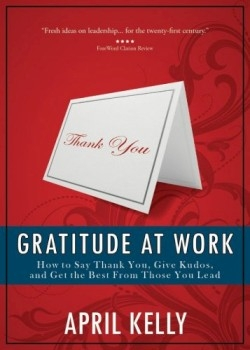Gratitude at Work
How to Say Thank You, Give Kudos, and Get the Best From Those You Lead
Gratitude at Work focuses on an important aspect of leadership that is often ignored. This is a book for the twenty-first century with fresh ideas on leadership and current examples of gratitude in action—and it’s about more than just saying thanks.
Author April Kelly shares her passion for developing high-performance customer-centric teams. She works as the senior director of customer operations at LinkedIn and was previously the director of account management at PayPal. She is also the president of Gratitude Academy which is dedicated to cultivating gratitude principles in the community.
“Gratitude like leadership begins with a choice. It’s more than saying thank you” Kelly writes. The first part of the book deals with leadership and four traits that make a good leader. Kelly encourages leaders to use creative means of showing gratitude to their staffs insisting that gratitude reinforces positive behavior. “Gratitude helps people feel better and when people feel better about themselves and about their environment they try harder they take more pride in what they do they care more” she writes. The author also explains how companies like Google successfully implement a corporate culture of gratitude and how that can help them attract and retain top talent.
Chapter eight explores the link between humanitarian capitalism and gratitude and offers some powerful ideas that corporate leaders can use to foster goodwill within their organizations and the external community. The book cites several examples including Newman’s Own brand of sauces and salad dressings which donates the proceeds from its sales to charities. Kelly stresses the point that when a company supports community services that its employees care about and gives employees the opportunity to participate the employees will appreciate it. While supporting the community is a motivating factor for employees corporate goodwill also provides positive press for the company which can translate into free advertising.
Kelly shares examples of some of the creative incentive programs she has implemented including sponsoring a sandcastle competition for employees that raised funds for local children’s services. In addition most of the chapters contain exercises that promote awareness of opportunities where showing gratitude has provided benefits or could potentially provide future benefits. Sprinkled throughout the book are sidebars with motivational quotes.
A clear concise conversational writing style and small pages provide for a quick read. The concepts in this book can be applied by anyone in a workplace setting—staff or management—to cultivate good working relationships motivate employees or create a culture of gratitude and humanitarianism. Kelly explains how on a personal level showing gratitude can foster cooperation loyalty relationships and positive feelings for both the giver and receiver.
Disclosure: This article is not an endorsement, but a review. The publisher of this book provided free copies of the book and paid a small fee to have their book reviewed by a professional reviewer. Foreword Reviews and Clarion Reviews make no guarantee that the publisher will receive a positive review. Foreword Magazine, Inc. is disclosing this in accordance with the Federal Trade Commission’s 16 CFR, Part 255.

